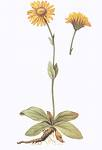Arnica Montana is a plant that belongs to the sunflower family. Common names for Arnica are leopard's bane, wolf's bane and mountain tabacco. Arnica naturally grows primarily in mountainous areas in Europe. The plant looks very similar to a dandelion and it is a poisonous plant if eaten.

picture above of Arnica Plant
Herbal Uses For Arnica
Arnica is used for sprain, strains and other aches and pains in ointments. The plant seems to create an antiflammatory effective. Arnica is applied externally to aches and pains. Arnica is generally not take internally because the plant is poisonous.
Homeopathic Uses For Arnica
Homeopathic arnica is diluted. This application is usually applied externally. Some homeopathic arnica prepartions may be taken orally since the poison has been diluted.
Homeopathic arnica is used primarily to treat aches, pains and bruises. The herbal preparation and the homeopathic preparation generally treat the same conditions.
Research on Arnica
There have been several double blind trials with Arnica Montana in Homeopathy.
| Vickers et al., 1998 | Randomized, double-blinded, placebo-controlled trial of 519 people; 400 completed the study. | Homeopathic remedies, including arnica, are not effective for muscle soreness following long-distance running. |
| Ernst and Pittler, 1998 | Systematic review of eight trials. | Rigorous clinical trials indicate arnica is not more effective than a placebo; most trials studied use of arnica for tissue trauma. |
These 2 trials were of the highest quailty. Other trials with Arnica exist but many of them had similar results to the trials above. Many people say that Arnica works for them.
Some trials showed a slightly positive result. A 2007 controlled study looked at homeopathic arnica in patients who had their tonsils removed. One group received arnica and the other placebo. Patients were surveyed afterward; 111 out of 190 patients returned their questionnaires. The arnica group reported slightly lower pain levels than the placebo group. However, the study was far from conclusive. The patients stayed in the hospital the same amount of time and took the same amount of pain killers.
The question remains is whether Arnica should be researched in double blind studies? Is this the best way to measure this homeopathic remedy? Is the homeopathic remedy effective in reducing soreness, brusing and inflammation? Let us hear your comments.
References
http://www.cancer.org/docroot/ETO/content/ETO_5_3X_Arnica.asp
http://nccam.nih.gov/health/homeopathy/







